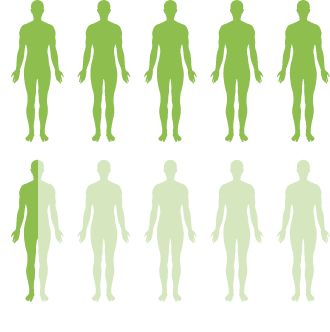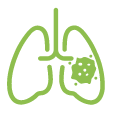

LEMS and Cancer
LEMS and Cancer

About 50%-60% of patients with LEMS have a co-occurring cancer
- LEMS occurs when the immune system mistakenly attacks a part of the nervous system called the neuromuscular junction. This is a part of the body where nerves communicate with muscles to control their movement.
- In LEMS patients where there’s a co-occurrence of cancer, the body produces antibodiesa type of protein produced by the immune system to fight infections that attack not only the tumor, but also the neuromuscular junction.
Screening for cancer
Once a diagnosis of LEMS is confirmed, your doctor may decide to run more tests. If your symptoms have progressed very quickly, it could be a sign that your LEMS is related to cancer.

Although LEMS also occurs with a variety of other cancers, it is most often associated with small cell lung cancer (SCLC) an aggressive, fast-growing cancer of the lungs

The majority of SCLC cases occur in people with a history of smoking
TESTS MAY INCLUDE A CT-SCAN
AND/OR A PET SCAN

If your doctor suspects SCLC, he or she may order a CT (computed tomography) scan or a PET (positron emission tomography) scan of your chest to see if a tumor is present. Once all the results are in, your doctor will discuss the best treatment plan for you.
Signs and Symptoms of Underlying Cancer
Specialists use a scoring system called DELTA-P to predict the likelihood that a patient’s LEMS symptoms are accompanied by underlying tumor. The name is an acronym drawn from each of the signs or risk factors associated with this type of LEMS.
D =
Difficulty swallowing/neck weakness
E =
Erectile dysfunction
L =
Loss of weight
T =
Tobacco use
A =
Age of onsetthe age that symptoms first appeared 50 years and older
P =
If any of these DELTA-P signs is relevant to you, reach out to your doctor to discuss.
Patients with cancer-related LEMS may face numerous daily challenges
Members of a panel of patients with cancer-related LEMS described their experiences and the effects on their lives and those around them.
Muscle Pain
Extreme fatigue, which makes it difficult to do day-to-day tasks and climb stairs
Trouble chewing due to jaw fatigue, which also causes slurred speech and dryness
Vision trouble
Inability to sleep, which also disrupts their family members’ sleep
Difficulty with self-care and heavy reliance on caregiver support
Patients reported feelings of depression
Treating LEMS
Related to Cancer
In cancer-related LEMS, the treatment team usually includes oncologists and neurologists who may use a coordinated effort to determine the appropriate treatment for you.
- The oncologists will treat the underlying cancer
- The neurologists will typically manage the symptoms of LEMS

GET GUIDANCE ON TALKING WITH AN ONCOLOGIST ABOUT LEMS AND CANCER
Download the Oncology Discussion Guide for tips on what questions to ask when meeting with an oncologist about cancer-related LEMS.
